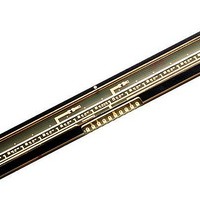TSL2014 TAOS, TSL2014 Datasheet - Page 4

TSL2014
Manufacturer Part Number
TSL2014
Description
Photodiodes Linear Array 200 DPI
Manufacturer
TAOS
Type
Linear Sensor Arrayr
Datasheet
1.TSL2014.pdf
(10 pages)
Specifications of TSL2014
Peak Wavelength
1000 nm
Maximum Rise Time
500 ns
Maximum Fall Time
500 ns
Maximum Operating Temperature
+ 70 C
Minimum Operating Temperature
0 C
Product
Photodiode
Lead Free Status / RoHS Status
Lead free / RoHS Compliant
TSL2014
896 y 1 LINEAR SENSOR ARRAY
TAOS040B − MAY 2007
Electrical Characteristics at f
R
NOTES: 1. The array is uniformly illuminated with a diffused LED source having a peak wavelength of 640 nm.
Timing Requirements (see Figure 1 and Figure 2)
NOTES: 8. Input pulses have the following characteristics: t
4
Copyright E 2007, TAOS Inc.
V
V
PRNU
R
SE
V
DSNU
IL
I
I
I
V
V
V
V
C
C
t
t
t
t
DD
IH
IL
su(SI)
h(SI)
w
r
L
, t
out
drk
sat
OH
OL
e
i(SI)
i(CLK)
f
= 330 Ω, E
Setup time, serial input (see Note 8)
Hold time, serial input (see Note 8 and Note 9)
Pulse duration, clock high or low
Input transition (rise and fall) time
Analog output voltage (white, average over 896 pixels)
Analog output voltage (dark, average over 896 pixels)
Pixel response nonuniformity
Nonlinearity of analog output voltage
Output noise voltage
Responsivity
Saturation exposure
Analog output saturation voltage
Dark signal nonuniformity
Image lag
Supply current, output idle
High-level input current
Low-level input current
High level output voltage SO1 and SO2
High-level output voltage, SO1 and SO2
Low level output voltage SO1 and SO2
Low-level output voltage, SO1 and SO2
Input capacitance, SI
Input capacitance, CLK
2. PRNU is the maximum difference between the voltage from any single pixel and the average output voltage from all pixels of the
3. Nonlinearity is defined as the maximum deviation from a best-fit straight line over the dark-to-white irradiance levels, as a percent
4. RMS noise is the standard deviation of a single-pixel output under constant illumination as observed over a 5-second period.
5. Minimum saturation exposure is calculated using the minimum V
6. DSNU is the difference between the maximum and minimum output voltage in the absence of illumination.
7. Image lag is a residual signal left in a pixel from a previous exposure. It is defined as a percent of white-level signal remaining after
9. SI must go low before the rising edge of the next clock pulse.
device under test when the array is uniformly illuminated at the white irradiance level. PRNU includes DSNU.
of analog output voltage (white).
a pixel is exposed to a white condition followed by a dark condition:
e
= 18μW/cm
PARAMETER
2
(unless otherwise noted)
clock
= 200 kHz, V
r
IL +
www.taosinc.com
V out (white) * V drk
r
V out (IL) * V drk
= 6 ns, t
See Note 1
See Notes 2 & 3
See Note 3
See Note 4
See Note 5
All pixels
See Note 7
V
V
I
I
I
I
O
O
O
O
DD
I
I
= V
= 0
= 50 μA
= 4 mA
= 50 μA
= 4 mA
f
= 5 V, T
= 6 ns.
TEST CONDITIONS
DD
sat
, the maximum V
A
100
= 25°C, λ
See Note 6
r
drk
p
, and the maximum R
= 640 nm, t
MIN
MIN
1.6
2.5
4.5
16
20
50
0
0
0
The LUMENOLOGY r Company
± 0.4%
0.5%
NOM
TYP
0.05
4.95
0.01
155
7%
3.4
4.6
0.4
22
25
53
35
70
int
2
1
= 5 ms,
e
.
MAX
MAX
0.15
20%
120
500
2.4
0.1
28
80
10
10
(μJ/cm
mVrms
nJ/cm
UNIT
UNIT
mV
mA
FS
μA
μA
pF
pF
V/
ns
ns
ns
ns
V
V
V
V
V
V
V
2
2
)



















